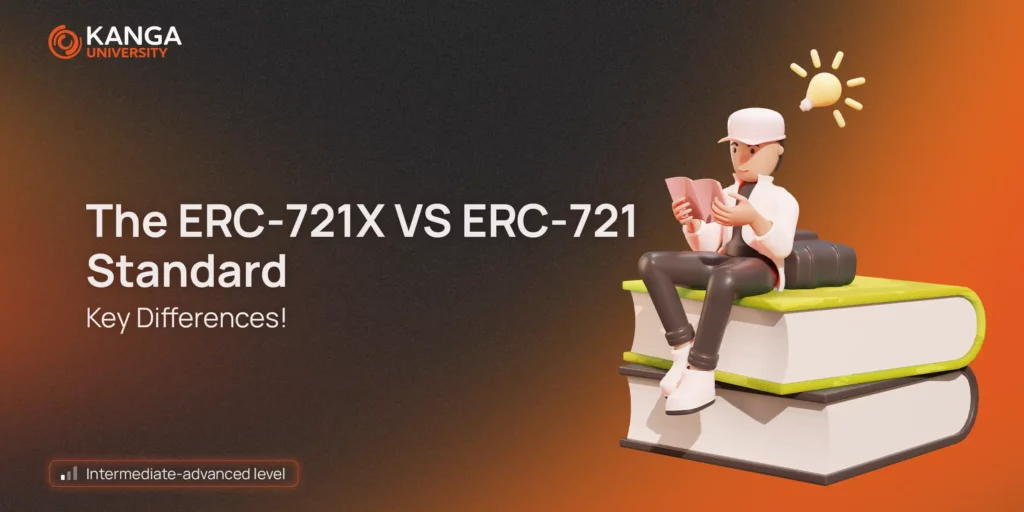
Tokens are designed within the blockchain. Each of them meets certain standards. Such a defined standard allows us to certify a given NFT and its authentication.
Every non-fungible token is generated through a smart contract, making it distinguishable and uniquely identifiable. The commonly used standard for this purpose is ERC-721.
More recently, because during the Bitcoin Ordinals boom, Solidity’s leading developer CyberKongz, OwlofMoistness developed an enhancement to this widely used standard. ERC-721X, as it is referred to, adds many beneficial layers of security to our NFTs. Let’s get to know it better and take a look at the key differences that define these two standards!
ERC – What Is It Exactly?
ERC, or “Ethereum Request for Comments.” This is a token standard that implements an API for smart contract tokens. It provides basic functions for these NFTs, such as:
- Transferring tokens from one account to another.
- Obtaining account balance.
- Obtaining information about the total supply of tokens available on the network.
- Confirming transactions.
The most common standard that we are familiar with is ERC-20. It is responsible for fungible NFTs. In practice, this means that each token is exactly the same in type and value as another token. For example: one ERC-20 token works similarly to 1 ETH.
ERC-721 – What Does This Standard Mean?
It is definitely an improvement for ERC-20. A token with this standard is unique, but at the same time can have a different value than a token from the same contract. How is this possible?
You need to know that all NFT tokens have a variable Unit256 function called TokenId. For each ERC-721 standard token, the combination of Contract Address, Unit256 and TokenId can be different. As a result, the TokenId function can use the input data and show us a picture of something really cool!
ERC-721 was invented by William Entriken, Dieter Shirley, Jacob Evans and Nastassia Sachs in January 2018.
The ERC-721X Standard: A New Proposal for Non-Fungible Tokens!
The new token standard is something like 2FA on-chain. There are many dangers lurking in the cryptocurrency sector. Scammers are just waiting for us to stumble and make a mistake. Hence the idea of ERC-721X, which is a token to protect NFT holders. ERC-721X offers two-factor authentication by designating the owner’s second wallet as a “gatekeeper,” ensuring NFT transfers require proper authorization.
How Does ERC-721X Work…?
This standard consists of two layers: locking and guarding.
The locking function is linked to the ERC-721 standard. When you lock your NFT, you use the lock registry. This is a system that combines with ERC-721 in its operation, and requires a small amount of gas. The function allows you to lock and unlock your resources. We cannot move our resources until they are removed from the lock registry.
The lock registry itself was created with parallel staking capabilities in mind. Assets staked this way can be used on multiple systems without losing ownership.
The second option of the ERC-721X standard is the guarding function. Instead of a wallet holding an NFT and blocking tokens, a wallet holding NFT data assigns a second wallet as a protection wallet. This is called the “Guardian” wallet. Such a wallet can then block assets in the wallet, and is also responsible for approving the tokens in question for transfer, seemingly creating a 2FA of the chain. The guardian wallet must be a cold wallet to ensure the highest level of security.
What Problems Does ERC-721X Solve?
First of all, the issue of security. We use hot wallets on a daily basis, because let’s be honest – they are convenient to use. However, with such convenience, come many dangers.
The guardian contract secures hot wallets. It allows us to safeguard our assets by adding another layer of protection, in the form of a second hardware wallet. With this standard, scams will be more difficult to carry out. Email attacks, social engineering scams, seed phrase scams – none of these methods will work if they are blocked with a second wallet.
Thanks to ERC-721X, the number of hacking attacks will be drastically reduced, saving hundreds of thousands, if not millions in NFT value for users!
Summary
The new standard will make the Web3 community feel even safer. The technology is a step forward to enhance the security of non-fungible tokens. Other projects are increasingly eager to adopt the ERC-721X standard in their collections.
ERC-721X was created to add a layer of security for NFT holders. It will allow users to participate in staking with a lock registry and designate a “Guardian” for two-factor authentication (2FA).
Complete today’s lesson!
- What is an NFT? [BEGINNER LEVEL]
- What is an ERC-20 token and how is it created? [INTERMEDIATE LEVEL]
- How to create your own NFT. [MASTER LEVEL]